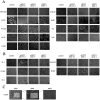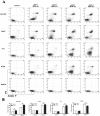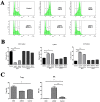A novel oncolytic herpes simplex virus type 2 has potent anti-tumor activity
- PMID: 24671154
- PMCID: PMC3966855
- DOI: 10.1371/journal.pone.0093103
A novel oncolytic herpes simplex virus type 2 has potent anti-tumor activity
Abstract
Oncolytic viruses are promising treatments for many kinds of solid tumors. In this study, we constructed a novel oncolytic herpes simplex virus type 2: oHSV2. We investigated the cytopathic effects of oHSV2 in vitro and tested its antitumor efficacy in a 4T1 breast cancer model. We compared its effect on the cell cycle and its immunologic impact with the traditional chemotherapeutic agent doxorubicin. In vitro data showed that oHSV2 infected most of the human and murine tumor cell lines and was highly oncolytic. oHSV2 infected and killed 4T1 tumor cells independent of their cell cycle phase, whereas doxorubicin mainly blocked cells that were in S and G2/M phase. In vivo study showed that both oHSV2 and doxorubicin had an antitumor effect, though the former was less toxic. oHSV2 treatment alone not only slowed down the growth of tumors without causing weight loss but also induced an elevation of NK cells and mild decrease of Tregs in spleen. In addition, combination therapy of doxorubicin followed by oHSV2 increased survival with weight loss than oHSV2 alone. The data showed that the oncolytic activity of oHSV2 was similar to oHSV1 in cell lines examined and in vivo. Therefore, we concluded that our virus is a safe and effective therapeutic agent for 4T1 breast cancer and that the sequential use of doxorubicin followed by oHSV2 could improve antitumor activity without enhancing doxorubicin's toxicity.
Conflict of interest statement
Figures







Similar articles
-
NK cell tumor therapy modulated by UV-inactivated oncolytic herpes simplex virus type 2 and checkpoint inhibitors.Transl Res. 2022 Feb;240:64-86. doi: 10.1016/j.trsl.2021.10.006. Epub 2021 Oct 29. Transl Res. 2022. PMID: 34757194
-
Antitumor effects of oncolytic herpes simplex virus type 2 against colorectal cancer in vitro and in vivo.Ther Clin Risk Manag. 2017 Feb 7;13:117-130. doi: 10.2147/TCRM.S128575. eCollection 2017. Ther Clin Risk Manag. 2017. PMID: 28223815 Free PMC article.
-
The construction of a new oncolytic herpes simplex virus expressing murine interleukin-15 with gene-editing technology.J Med Virol. 2020 Dec;92(12):3617-3627. doi: 10.1002/jmv.25691. Epub 2020 Feb 14. J Med Virol. 2020. PMID: 31994741
-
Oncolytic virus therapy using genetically engineered herpes simplex viruses.Front Biosci. 2008 Jan 1;13:2060-4. doi: 10.2741/2823. Front Biosci. 2008. PMID: 17981691 Review.
-
Herpes Simplex Virus Oncolytic Immunovirotherapy: The Blossoming Branch of Multimodal Therapy.Int J Mol Sci. 2020 Nov 5;21(21):8310. doi: 10.3390/ijms21218310. Int J Mol Sci. 2020. PMID: 33167582 Free PMC article. Review.
Cited by
-
Drug clinical trials on high-grade gliomas: challenges and hopes.Cancer Biol Med. 2024 Feb 5;20(12):947-54. doi: 10.20892/j.issn.2095-3941.2023.0364. Cancer Biol Med. 2024. PMID: 38318805 Free PMC article. No abstract available.
-
OH2 oncolytic virus inhibits non-small-cell lung cancer metastasis via β-catenin pathway suppression.Commun Biol. 2025 Jul 28;8(1):1115. doi: 10.1038/s42003-025-08520-y. Commun Biol. 2025. PMID: 40721857 Free PMC article.
-
Emerging role of Natural killer cells in oncolytic virotherapy.Immunotargets Ther. 2015 Mar 31;4:65-77. doi: 10.2147/ITT.S55549. eCollection 2015. Immunotargets Ther. 2015. PMID: 27471713 Free PMC article. Review.
-
The long-term effectiveness and mechanism of oncolytic virotherapy combined with anti-PD-L1 antibody in colorectal cancer patient.Cancer Gene Ther. 2024 Sep;31(9):1412-1426. doi: 10.1038/s41417-024-00807-2. Epub 2024 Jul 27. Cancer Gene Ther. 2024. PMID: 39068234 Free PMC article.
-
Cytotoxic effect of dual fluorescent-labeled oncolytic herpes simplex virus type 1 on mouse tumorigenic cell lines.Res Pharm Sci. 2019 Feb;14(1):27-35. doi: 10.4103/1735-5362.251850. Res Pharm Sci. 2019. PMID: 30936930 Free PMC article.
References
Publication types
MeSH terms
Substances
LinkOut - more resources
Full Text Sources
Other Literature Sources

